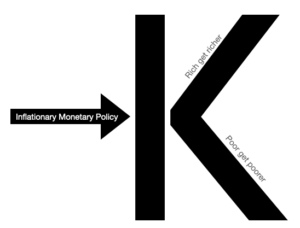
While I generally avoid mutual funds like the plague, I don’t avoid the stock market altogether. I’ll split what I do in the stock market into two categories: long and short. Either way, I’m honest with myself in admitting that no matter what I do in the stock market, it will be speculative and risky.
Long
“Going long” means buying a stock and expecting its price or income to rise so I can sell later for a profit. There are millions of people who have access to the same information as you, and that is generally reflected in the price of that stock. If you know something non-public about the company, trading it may be illegal for you. I’ve bought individual stocks before; I just treat the situation honestly; it is speculative in nature, and I only make such trades with very small portions of my portfolio.
I don’t go long on mutual funds because I don’t know what I’m going long on. It is virtually impossible to know what I’m actually investing in when I buy shares of a fund.
 Short
Short
Selling Short… A short position is the opposite of a long one. Instead of buying low and selling high, selling short is a matter of selling high and then buying low. For me to do this, I borrow shares of a stock and simultaneously sell them at the market price in expectation of a price decrease. To close this position later, I just have to buy back shares of the same stock at the then market price and pay back the borrowed stock. If during my position the stock price declined, I profit; if the stock price increased, I have a loss.
Ex: ABC Company seems to be doomed. It’s currently trading at $50, but I think it will go much lower over the next couple months. I sell 100 shares short. This means I borrow 100 shares and simultaneously sell them for $5,000. A few months later I see the stock price has declined to $35. To close my position, I buy 100 shares back for $3,500. I pay back the borrowed shares and retain the $1,500 profit, less fees and commissions.
I like short selling more than going long. I often notice stocks crashing down faster and more predictably than they spike up. It also might be easier to confidently predict the demise of a company than the thriving of one. In the past, I liked a wind energy stock, but felt more strongly about the decline of home builders and mortgage lenders. So to me the better investment was to sell home builders and mortgage lenders short. Wind energy may really take off… but who knows if the company I’m looking at will be a forerunner. On the other hand, when the mortgage market is headed downhill, just about any mortgage company is going to be hurt, and it’s very easy to target those who readily admit to holding subprime notes.
Buying Put Options… Buying a put option is similar to short selling in that it is done when you expect a stock price to decline. Buying a put option means buying the right to sell a stock at a certain price. You don’t actually sell it right away; you just pay a premium for the right to sell it at a certain price in a certain window of time. If the stock price goes down, you can sell the option for a higher premium than you paid or you can exercise your option to claim the profit. I don’t like put options as much, because if a stock is already falling, then the premium you pay to buy the put rises because the seller of the put option knows it’s falling. That same already falling stock can be sold short (as soon as its price has an up tick) with no premium to pay.
Inverse Index Funds… An index fund is one that attempts to closely mimic the price movements of an entire group of stocks (an index) such as the S&P 500. Most index funds allow you to effectively “go long” on all the stocks in the index. An inverse index fund enables you mimic selling short an entire index. Such a fund is invested in a way that attempts to have price movements that are the opposite of the chosen index. So an inverse S&P 500 fund will go up in price $1 for every $1 decline in the S&P 500. It will also go down $1 for every $1 rise in price of the index. For extremely leveraged speculation, you can even choose a double inverse index fund – where the fund goes up $2 for every $1 that the chosen index declines. It also goes down $2 for every $1 rise in the chosen index.
The Window of Opportunity
The wild thing is that many people who own stocks or mutual funds aren’t even aware of short positions, leaving them with only long strategies. This benefits me because when a stock or fund is declining in value, financial advisors are often telling people to hold on for the long term. This keeps the price from falling too rapidly. As a result of the “hopers”, there is enough time for me to see the decline and still have time to profit from short selling it before its downward movement concludes.


